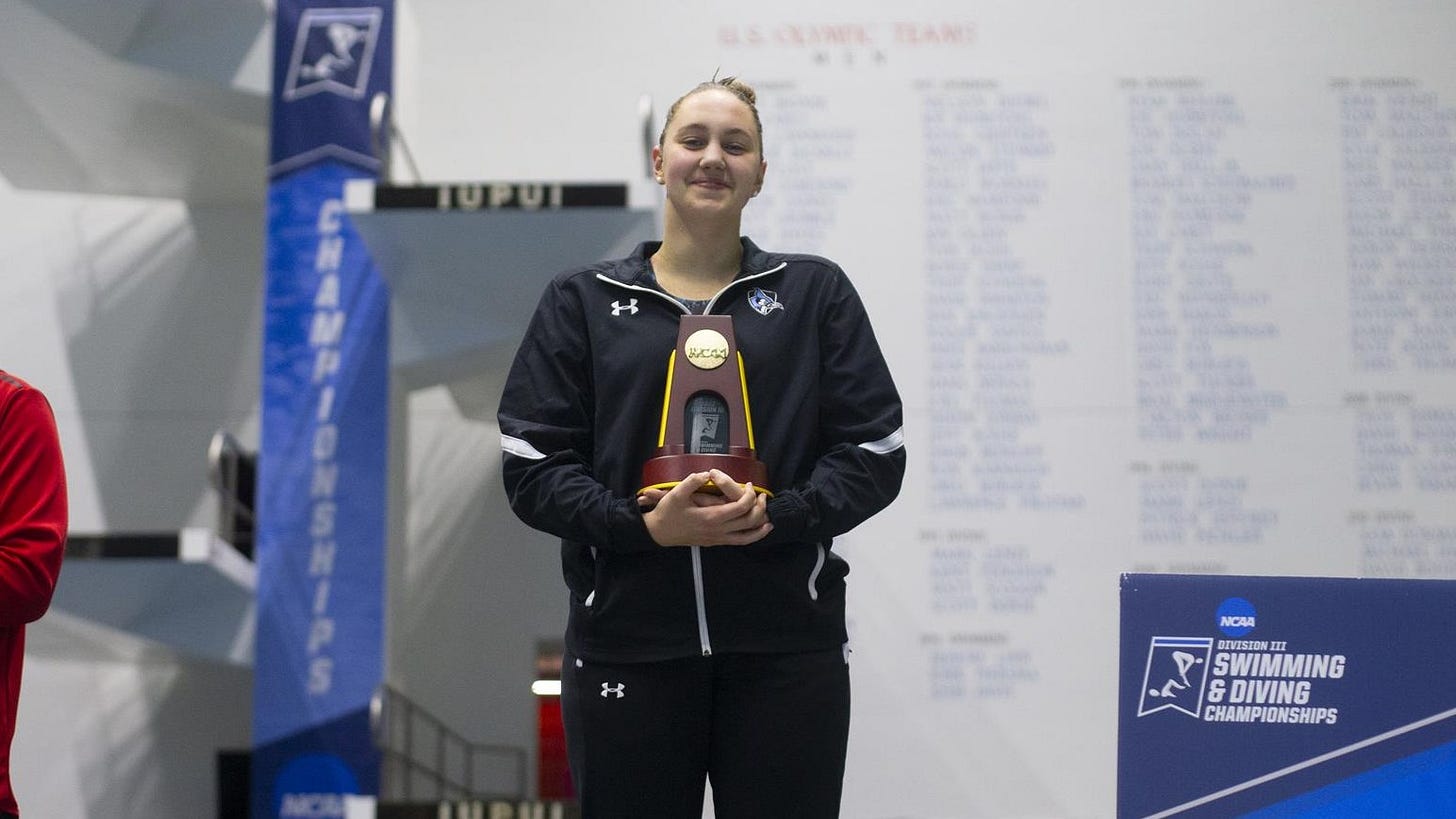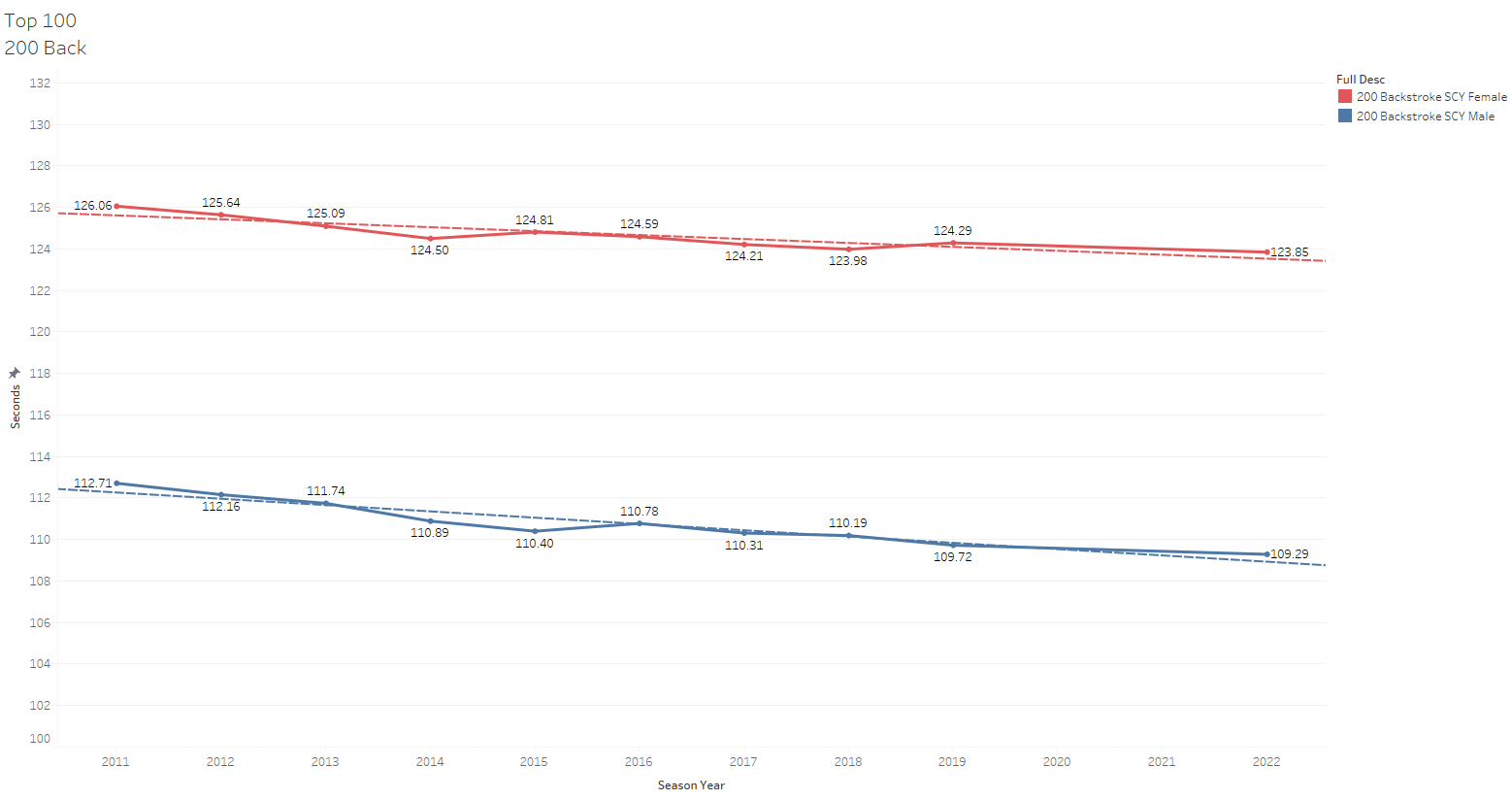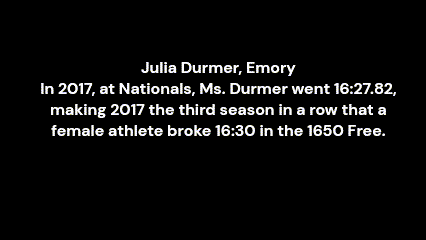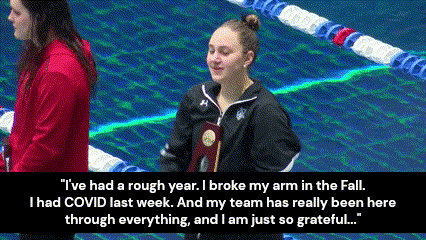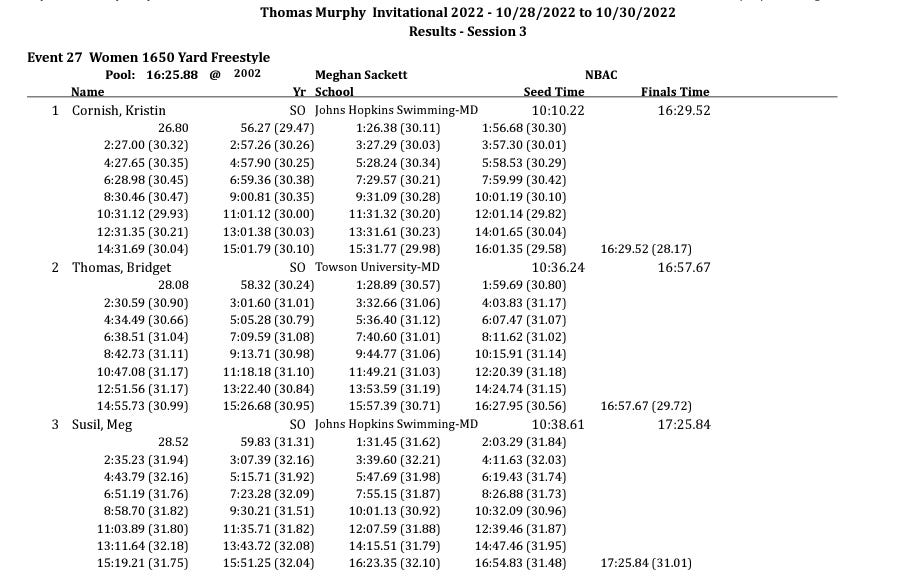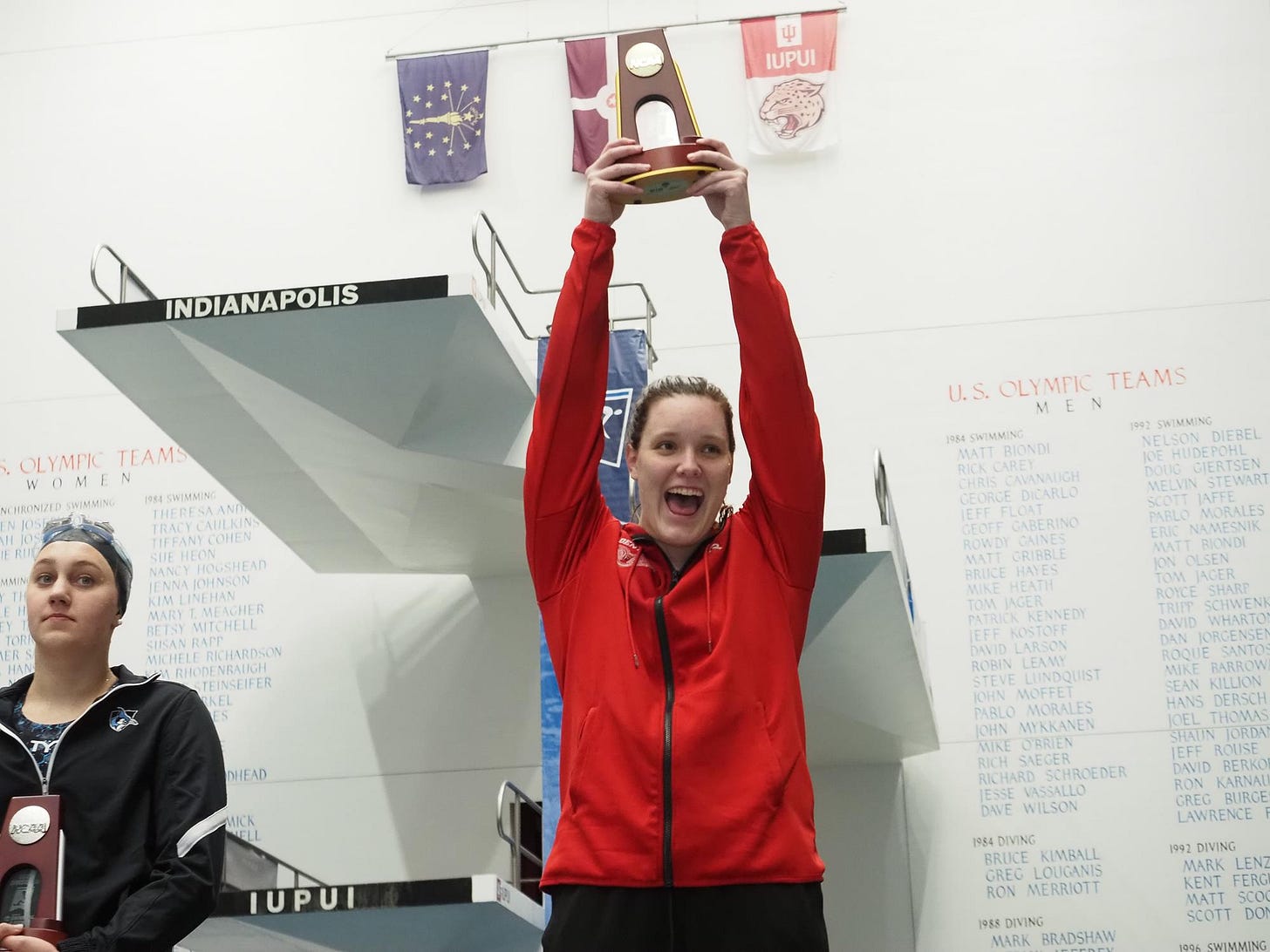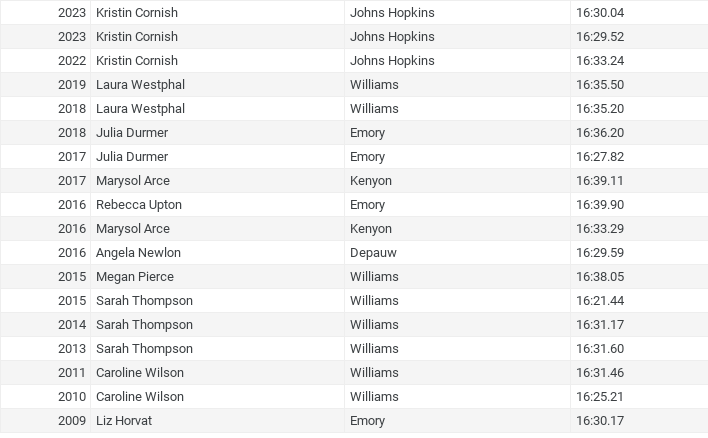Johns Hopkins Sophomore Kristin Cornish is poised to do something unprecedented in the 1650.1
And to understand it, we need to take a quick look at why the Women’s 1650 is so interesting right now. **Spoiler alert - it is not because things are going well.**
A pointed and overly short history of long swims
At Nationals, the longest swim is the 1650 Freestyle, essentially a mile at the fastest speed you can manage.
It looks hellish. And solitary. In nearly every other event, you hit the water and then a minute or two later you are on the deck hugging or high-fiving teammates. But the mile seems to require a different mindset. And skillset, as the athletes who excel at distance freestyle events - a list that includes the single best swimmer in the history of the sport2 - have the ability to swim the laps with a hypnotizing metronomic regularity.
In Division III, we get to watch elite swimmers performing this grueling feat at a very high level. (And better them than us.) But we noticed a few unexpected things about Women’s 1650.
In every event contested at Nationals - individual events and relays, Men’s and Women’s - if you look at the top 100 swims in each event in each of the last ten full seasons (2011-19 & 2022), the trend line points down (meaning, towards faster times, year after year) and our confidence in that trend is high (a p-value of <0.05, meaning the signal is strong enough that we can reject the null hypothesis that there is no trend, just error or randomness).
In every event. Except one. (Wait for it...)
Here’s an example of a typical event and a typical trend. In 200 Back, both Men’s and Women’s, there is a clear downward (faster) trend in times recorded in the top 100 swims per season.3 It looks like this:
So, what does that have to do with the Women’s 1650? Well, it is an example of the typical trend, which is relevant because the Women’s 1650 is atypical:
You can see that the Men’s 1650 is trending down. And, in case you were wondering, the p-value is 0.0002 (well under the <0.05 threshold). That means Men’s 1650 is similar to the other events swum at championship meets: there’s a negative trend line (the average of the top 100 swims per year trends faster, year-after-year), with p-values under 0.05.
But not only is the Women’s 1650 trend line (basically) flat, the p-value is 0.11, well over our <0.05 threshold for rejecting the null hypothesis. So, we can’t reject the null hypothesis. That means that even if - to an observer - that line looks like it might be trending down, one has to err on the side of doubt.
Maybe times in Women’s 1650 are getting marginally faster, or maybe not. We have 10 years of data, tracking more than 1,000 competitive swims, and we simply cannot tell.
We can be confident in every other event that swims are getting faster.
Women’s 1650 is having a very weird moment. A weird moment that just gets weirder.
Nationals invites and Women’s 1650
Let’s narrow our focus to the faster swims - the swims that earn the swimmer an invite to Nationals. Invite times go up and down depending on the times swum that season.
Last season (2022) about half the invite times were faster than ever.4 That tells you how deep the talent pool was. Invite times for the remaining events were somewhere in the middle (faster than in some years, but slower than in some others). With one exception.
That one exception - among all events contested at Nationals - where the 2022 invite time was slower than it has been in any season since 2011? Women's 1650 Free.5
Women’s 1650 and the elusive threshold of 16:30
Now let’s pull our focus even tighter, to the Women’s 1650 swims that reached an elusive threshold: 16:30.
It is really unusual for a Division III athlete to swim the Women’s 1650 in less than 16 minutes and 30 seconds.
5 times total: The 16:30 mark has been broken five times in the history of Division III.
Never more than once per season: No two swims (from one or more athletes) ever broke the 16:30 mark in the same Division III season.
Only once per career: No single athlete broke 16:30 more than once in her entire Division III career. 6
A very short list of athletes who broke 16:30
Caroline Wilson: On March 19, 2010 Caroline Wilson of Williams College became the first athlete to break 16:30 in Women’s 1650 (16:25.21).
Sarah Thompson: Five years and one day later (March 21, 2015), Sarah Thompson, also of Williams College, became the second athlete in the history of Division III to break 16:30 in the 1650 Free. In the process, Ms. Thompson set an NCAA record that still stands (16:21.44). At the time, Ms. Thompson was a Senior and never again swam the event in NCAA competition.
Angela Newlon: In 2016, at the NCAC conference championships, Depauw Junior Angela Newlon posted a 16:29.59. Ms. Newlon later finished third in 1650 at Nationals with a 16:42.48. Ms. Newlon swam the event three more times as a Senior with a best time of 16:52.33.
Julia Durmer: In 2017, at Nationals, Emory’s Julia Durmer (a transfer from the University of Virginia) went 16:27.82, making 2017 the third season in a row that a female athlete broke 16:30 in the mile.
And until this year, that was it - that was the list. No other Division III swimmers beat 16:30 in Women’s 1650. Ever.
So what is the big deal about Kristin Cornish?
Last year Ms. Cornish, as a first-year swimmer, broke her arm at the beginning of the 2021-22 season. Then - the week before Nationals - she got COVID.7
Then Ms. Cornish went out and won the 1650 at 2022 Nationals with a 16:33.24.
This season, Ms. Cornish is poised to do something unprecedented.
It started with her swim in late October. Kristin Cornish swam the 1650 in 16:29.52.
That’s interesting for a few reasons. First, someone - anyone - broke 16:30, for the first time since March 18, 2017.
Second, Ms. Cornish broke 16:30 in the Fall (Oct. 30). The other swimmers who broke 16:30 did so at the end of the year:
Caroline Wilson, March 20, 2010 (Nationals)
Sarah Thompson, March 21, 2015 (Nationals)
Angela Newlon, February 13, 2016 (NCAC Championships)
Julia Durmer, March 18, 2017 (Nationals)
Third, Ms. Cornish went out and hit 16:30.04 about a month later. Here are the two best times per season for the swimmers who broke 16:30 in the Women’s 1650.
Caroline Wilson (2010): 16:57.22 and 16:25.21 (27.23 sec from breaking 16:30 again)
Sarah Thompson (2015): 16:53.55 and 16:21.44 (23.59 sec from breaking 16:30 again)
Angela Newlon (2016): 16:29.59 and 16:42.48 (12.49 sec from breaking 16:30 again)
Julia Durmer (2017): 17:00.37 and 16:27.82 (30.39 sec from breaking 16:30 again)
Kristin Cornish (2023): 16:29.52 and 16:30.04 (0.05 sec from breaking 16:30 again)8
Before Kristin Cornish, no one who broke 16:30 in the Women’s 1650 ever came within 12.49 seconds of breaking 16:30 again in the same season. And 12.49 seconds is a long time in swimming. A moderately fast sprinter in the Women’s 50 Free will go a full length of the pool in much much less than 12.49 seconds.9
By contrast, a blink of the eye takes 0.10 seconds, twice as long as the margin by which Ms. Cornish missed breaking 16:30 for a 2nd time this Fall.
By contrast, a blink of the eye takes 0.10 seconds, twice as long as the margin by which Ms. Cornish missed breaking 16:30 for a 2nd time this Fall.
Digression: If we loosen the threshold constraints by 10 seconds, and instead look at swims under 16:40, Ms. Cornish is the first swimmer in Division III history to swim the 1650 under 16:40 twice in one season.10
If Ms. Cornish breaks 16:30 this Spring…
Bracket for a moment the 2015 Sarah Thompson record (16:21.44), which seemed so far out of reach, and now looks vulnerable.
If Ms. Cornish breaks 16:30 this Spring, it will be her second time this season. And the word ‘unprecedented’ doesn’t quite capture it.
It never before happened twice in one season: There has never been a Division III season where 16:30 was broken twice, by a single athlete or any combination of athletes.
It never before happened twice in the career of one athlete: There has never been a Division III athlete who broke 16:30 twice in her entire career.
If Ms. Cornish breaks 16:30 twice…in one season, it will be the greatest season in history for any Division III athlete competing in Women’s 1650 Free.
All the current epic battles in Division III swimming involve multiple athletes competing for the top spot. Hamilton/Meyer, Wei/Wager/Gill/Chen/Fadely/Wentzel, Kosian/Filion/Janicki.
Ms. Cornish stands all alone, locked in a battle with the history of the event itself. And there is mounting evidence that this is a battle she may win.
If you are watching Nationals this Spring, you are likely to first notice Ms. Cornish in the 500 Free.
Ms. Cornish currently leads Division III in the 500 Free. Her lead on the field right now is significant, but by the time Nationals rolls around this should have more of the flavor of a battle royale. Among the group of swimmers close behind Ms. Cornish are Caitlin Marshall of NYU, Madeleine Dunn and Katelin Isakoff of Tufts, the ever-present Jordyn Wentzel, the obligatory dangerous distance swimmer from Emory (in this case it is Jada Chatoor), Missy Leonard (a surprise entry from Ursinus who is tearing through the Centennial Conference) and three athletes from Denison - Quinn Brown, Tara Witkowski and last years 500 Free champion Taryn Wisner.
Ms. Cornish is a plausible candidate to win this highly competitive event, but who knows.
Insert pointless Ledecky vs. Phelps argument here.
Not that you asked, but the p-values on these trends are really low. Basically, that means we can trust our eyes if the trend-line looks like it is going down (meaning times are getting faster year after year). Again, it means we can reject the null hypothesis (the hypothesis that we are seeing an illusion created by error or randomness).
The p-values are less than 0.0001 for the Men’s 200 Back, and 0.0004 for the Women’s 200 Back. Nothing in this world is 100%. but this is pretty good, and the following statement is supported by the data: the times recorded in these events are getting faster.
When we say ‘ever’ - we mean within the period of time for which we have reliable and complete data - 2011-19 & 2022.
In case the wording is confusing, the invite time for Nationals in 2022 was 17:21.21. The only time, in the last ten full seasons when the invite time was slower was 2011 (17:25.42). In all other events, the 2022 invite time was either faster than it had ever been, or at least you did not have to go all the way back to 2011 to find an invite time that was slower.
With NCAA records, we have complete data on records going back to the founding of Division III.
We can also show that before 2010, no one broke 16:30 in the Women’s 1650, and after that point we do have the complete set of data for the top 100 swims in this event for 2011-19 & 2022.
We want to be clear. Ms. Cornish was clear to participate at Nationals, with all that entails - negative tests and waiting periods. There is no cause to suggest otherwise. We included this gif not to suggest that Ms. Cornish was somehow still sick and endangering others, but instead to show that she was still suffering the after-effects of the illness.
If you have had COVID, you know that long after you are no longer contagious or testing positive, it can feel like someone took sandpaper to your respiratory system. Ms. Cornish was still suffering from these effects. And Ms. Cornish still won the 1650 in 16:33.24.
Yes, Ms. Cornish swam these races in Oct. and Dec. 2022, but we count that as part of the 2023 season (the current season).
As a random example, the top 15 finishers in Women’s 50 Free at the Denison Invitational - a reasonably fast midseason meet - all beat 12.49 on their return length of the event (not the part of the race aided by jumping-off the blocks). The top four finishers all did their return length in less than 12 seconds.
Here are all the sub-16:40 swims in the history of Division III Women’s 1650 Free.
Liz Horvat of Emory went 16:30.17 on 3/21/2009 - that was the first sub 16:40 1650 Free in Division III history.
Only two swimmers broke 16:40 three times in their careers. Sarah Thompson - the current record holder - broke 16:40 once per year, every year from 2013-2015. It was in 2015, as a Senior, the Ms. Thompson set the current record.
The other swimmer to break 16:40 three times is Kristin Cornish. She is the only swimmer in Division III history to break 16:40 twice in one season (2023).
And this: while Ms. Thompson broke 16:40 three times, the first time was at Nationals in her Sophomore year. Ms. Cornish will go into her Sophomore year Nationals having already broken 16:40 three times (at least).
If you want to argue that Ms. Cornish is NOT the greatest Women’s 1650 swimmer in the history of Division III, do it fast. Because soon, possibly in the next two months, that argument will (almost certainly) be laughable.




